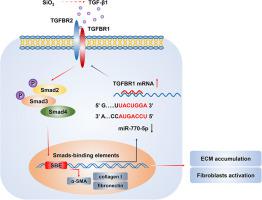Ecotoxicology and Environmental Safety ( IF 6.2 ) Pub Date : 2021-05-31 , DOI: 10.1016/j.ecoenv.2021.112372 Jiali Yuan 1 , Ping Li 1 , Honghong Pan 1 , Qi Xu 1 , Tiantian Xu 1 , Yan Li 1 , Dong Wei 2 , Yiqun Mo 3 , Qunwei Zhang 3 , Jingyu Chen 2 , Chunhui Ni 1

|
Silicosis is a devastating interstitial lung disease arising from long-term exposure to inhalable silica. Regrettably, no therapy currently can effectively reverse the silica-induced fibrotic lesion. Emerging evidence has indicated that the dysregulation of microRNAs is involved in silica-induced pulmonary fibrosis. The aim of this study is to explore the expression pattern and underlying mechanisms of miR-770–5p in silica-induced pulmonary fibrosis. Consistent with our previous miRNA microarray analysis, the results of qRT-PCR showed that miR-770–5p expression was downregulated in silica-induced pulmonary fibrosis in humans and animal models. Administration of miR-770–5p agomir significantly reduced the fibrotic lesions in the lungs of mice exposed to silica dust. MiR-770–5p also exhibited a dramatic reduction in TGF-β1-activated human pulmonary fibroblasts (MRC-5). Transfection of miR-770–5p mimics significantly decreased the viability, migration ability, and S/G0 phase distribution, as well as the expression of fibronectin, collagen I, and α-SMA in TGF-β1-treated MRC-5 cells. Transforming growth factor-β receptor 1 (TGFBR1) was confirmed as a direct target of regulation by miR-770–5p. The expression of TGFBR1 was significantly increased in pulmonary fibrosis. Knockdown of TGFBR1 blocked the transduction of the TGF-β1 signaling pathway and attenuated the activation of MRC-5 cells, while overexpression of TGFBR1 effectively restored the activation of MRC-5 cells inhibited by miR-770–5p. Together, our results demonstrated that miR-770–5p exerted an anti-fibrotic effect in silica-induced pulmonary fibrosis by targeting TGFBR1. Targeting miR-770–5p might provide a new therapeutic strategy to prevent the abnormal activation of pulmonary fibroblasts in silicosis.
中文翻译:

miR-770-5p 通过靶向 TGFBR1 抑制肺成纤维细胞的活化和二氧化硅诱导的肺纤维化
矽肺是一种破坏性的间质性肺病,由长期接触可吸入二氧化硅引起。遗憾的是,目前没有任何疗法可以有效逆转二氧化硅引起的纤维化病变。新出现的证据表明,microRNA 的失调与二氧化硅诱导的肺纤维化有关。本研究的目的是探索 miR-770-5p 在二氧化硅诱导的肺纤维化中的表达模式和潜在机制。与我们之前的 miRNA 微阵列分析一致,qRT-PCR 结果显示 miR-770-5p 表达在人类和动物模型中二氧化硅诱导的肺纤维化中下调。施用 miR-770-5p agomir 显着减少了暴露于二氧化硅粉尘的小鼠肺中的纤维化病变。MiR-770-5p 还表现出 TGF-β1 激活的人肺成纤维细胞 (MRC-5) 的显着减少。miR-770-5p 模拟物的转染显着降低了 TGF-β1 处理的 MRC-5 细胞中的活力、迁移能力和 S/G0 期分布,以及纤连蛋白、胶原蛋白 I 和 α-SMA 的表达。转化生长因子-β受体1(TGFBR1)被证实是miR-770-5p调控的直接目标。TGFBR1的表达在肺纤维化中显着增加。敲低 TGFBR1 阻断了 TGF-β1 信号通路的转导并减弱了 MRC-5 细胞的活化,而 TGFBR1 的过表达有效地恢复了被 miR-770-5p 抑制的 MRC-5 细胞的活化。一起,我们的结果表明 miR-770-5p 通过靶向 TGFBR1 在二氧化硅诱导的肺纤维化中发挥抗纤维化作用。靶向 miR-770-5p 可能提供一种新的治疗策略,以防止矽肺中肺成纤维细胞的异常活化。











































 京公网安备 11010802027423号
京公网安备 11010802027423号